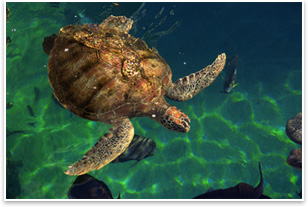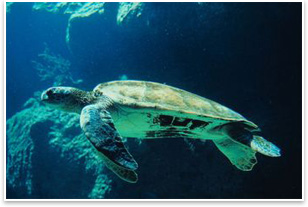
| Coming Out of Its Shell—Barrier Island Sanctuary Breaks Ground Refuge center to offer programs on endangered sea turtles, native habitat
Green building design promotes habitat education
A boardwalk connecting visitors to an already-in-place, mile-long nature trail encourages visitors to go turtle gazing, while a universally accessible coastal viewing platform provides visual access to the beach, allowing all visitors to see nocturnal turtles nesting on the shores of the center. A universally accessible coastal viewing platform provides visual access to the beach “Because of the unique purpose for this environmental learning center, the client team was composed of partnership groups related to the continued guardianship of the sea turtle population that regularly nests along this coastal area as well as to the preservation of the native habitat of the Archie Carr Refuge,” Douglas explains. Project survives hurricanes If you're going to develop on a barrier island, this building is the way you should do it “Our goal is for this project to serve as a demonstration that ‘'if you're going to develop on a barrier island, this building is the way you should do it,’” Douglas points out. “In light of the damaging hurricanes that impacted Florida in 2004 and 2005, particularly the east central coast, it's imperative that all new coastal construction be sensitive to the demands of the environment unique to this region of Florida by designing to address the forces of nature as well as preserving the natural environment.” The center is named after Archie Carr, world-renowned sea turtle expert and ecologist and founder of the CCC. Carr passed away in 1987. |
||
Copyright 2007 The American Institute of Architects. All rights reserved. Home Page |
||
news headlines
practice
business
design
recent related
› Integrated Design/Integrated Development Conference Selects Four Winning Green Projects (Missisquoi National Wildlife Refuge)
› Guemes Island Reaches Far for AIA Sustainable Design
› Guemes Island Reaches Far for AIA Sustainable Design
Did you know . . .
• Sea turtles are among the largest living reptiles. They evolved from land turtles.
• Loggerhead turtles are named for their large heads.
• Unlike land turtles, sea turtles spend almost their entire lives in the sea, gliding through the water with flipper-like forelimbs.
• Sea turtles frequently come to the surface to breathe when active. When they are resting, they can remain underwater for as long as two hours without breathing.
• Sea turtles make tracks on the beach.
• A National Academy of Sciences panel reported that drowning in shrimp trawls is the greatest source of human-caused mortality for sea turtles in U.S. waters, estimating that, without preventive measures, as many as 55,000 may drown every year.
• The Environmentally Endangered Lands (EEL) Program was established in 1990 to protect the natural habitats of Brevard County by acquiring environmentally sensitive lands for conservation, passive recreation, and environmental education.


 Sea turtles are either threatened or endangered, depending on the species. Despite the name, sea turtles lay their eggs on land, nesting on beaches. Archie Carr National Wildlife Refuge, established in 1991, is dubbed “Our Nation's Most Important Sea Turtle Refuge.” A 20-mile section of coastline from Melbourne Beach to Wabasso Beach in Florida, it is home to 25 percent of all loggerhead sea turtle nests and 35 percent of all green sea turtle nests in the U.S., making it the second most important nesting beach in the world. A total of 15,000-20,000 sea turtle nests are created annually there, with as many as 1,000 turtle nests per mile. The refuge also provides habitat for several other threatened and endangered species. The new Barrier Island Sanctuary Management and Education Center, located on a barrier island three miles north of Sebastian Inlet, will give visitors an opportunity to observe and learn about the refuge’s sea turtles and other barrier island habitats.
Sea turtles are either threatened or endangered, depending on the species. Despite the name, sea turtles lay their eggs on land, nesting on beaches. Archie Carr National Wildlife Refuge, established in 1991, is dubbed “Our Nation's Most Important Sea Turtle Refuge.” A 20-mile section of coastline from Melbourne Beach to Wabasso Beach in Florida, it is home to 25 percent of all loggerhead sea turtle nests and 35 percent of all green sea turtle nests in the U.S., making it the second most important nesting beach in the world. A total of 15,000-20,000 sea turtle nests are created annually there, with as many as 1,000 turtle nests per mile. The refuge also provides habitat for several other threatened and endangered species. The new Barrier Island Sanctuary Management and Education Center, located on a barrier island three miles north of Sebastian Inlet, will give visitors an opportunity to observe and learn about the refuge’s sea turtles and other barrier island habitats.